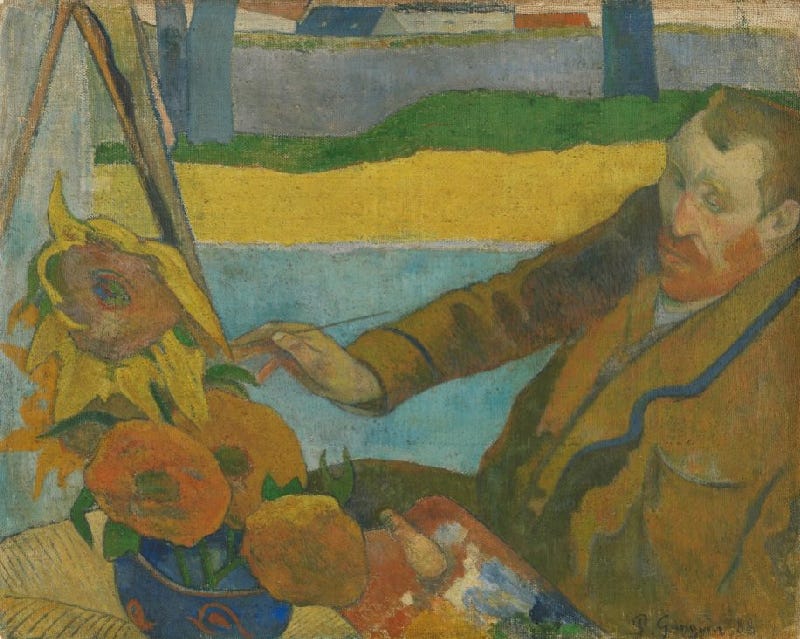The shared struggles of the Human Condition
Learn how historical and contemporary figures turned inner conflicts into strengths, as well as practical strategies for personal growth in 2024
The novelty, rather than the greatness of things, tempts us to inquire into their causes1 .
Michel de Montaigne, Essays
Are you struggling to balance your true self with the persona you present, feeling disconnected, unfulfilled, and uncertain of who you truly are?
To support myself, I look to figures who have transformed personal struggles into strengths while staying true to their inner selves.
Notable examples include
Sylvia Plath, who confronted her demons through writing
Vincent van Gogh, who expressed his turmoil through art
Thich Nhất Hanh, who used mindfulness to turn conflict into compassion
Nikola Tesla, who revolutionized technology through innovation
Howard Schultz, who built Starbucks from humble beginnings
These examples show that by embracing authenticity and turning personal struggles into strengths, you can overcome feelings of disconnection and uncertainty, finding fulfillment and making meaningful contributions.
Psychological Wholeness: Reconciling Opposing Elements Within Ourselves
The journey toward psychological wholeness starts with recognizing and integrating the opposing elements within ourselves.
Instead of seeking perfection or eradicating inner conflicts, it involves embracing our shadow self2—the unconscious aspects we often suppress or deny.
This process, known as individuation, was introduced by Carl Jung.
The process involves three distinct parts:
transforms internal struggles into opportunities for growth
deepens our connection with our true selves
enhances psychological resilience and emotional intelligence
Sylvia Plath embodies this transformative journey; her work captures her battle with inner demons and underscores the powerful link between vulnerability and creative expression.
Finding Voice Through Vulnerability—Sylvia Plath
As the acclaimed poet and author of The Bell Jar, Sylvia Plath struggled with severe depression and societal pressures, which evidently shapes her work.
In The Bell Jar, Plath explores various through the captivating portrayal of Esther Greenwood, and is based on Plath's own struggles with mental illness, societal pressures, and the tension between her ambitions and traditional female roles in the 1950s.
Plath is also largely renowned for her poems, such as “Lady Lazarus” and “Daddy,” where she confronts her inner demons with raw emotion, turning personal pain into universal themes of struggle and resilience.
Works like “Ariel” and “Mirror” explore her quest for freedom and self-reflection, highlighting the power of creative expression to integrate the shadow self.
Plath’s raw honesty in her writing reflects her deep self-awareness as she explored inner conflicts and emotions, but her tragic end highlights the challenges of unresolved struggles—a struggle also evident in the life of Vincent van Gogh.
Transforming Pain into Art—Vincent van Gogh
Van Gogh, one of history’s most renowned artists.
The Starry Night, inspired by the view from van Gogh’s asylum window, blends observation with imagination, using vivid colors and expressive brushwork to create a symbolic, mood-driven landscape that showcases his innovative painting techniques.
Van Gogh’s Sunflowers, created as color experiments and personal symbols of gratitude, became iconic through his unique portrayal of the flowers, which diverged from traditional still life’s and were deeply meaningful to him.
They adorned Paul Gauguin’s room as a gesture of artistic camaraderie, became synonymous with his identity as an artist, and were celebrated worldwide in multiple versions found in museums across the globe.
Van Gogh’s self-portraits and emotionally charged landscapes reflect his deep struggle with identity and inner conflicts, as he used art to process and express his emotional pain, transforming personal turmoil into universally resonant works and seeking personal wholeness through creativity.
This journey of transforming inner conflict into creative expression mirrors the approach of Thich Nhất Hanh.
Peace and Mindfulness Amidst Conflict—Thich Nhất Hanh
During the Vietnam War, Thich Nhất Hanh faced significant internal and external conflicts.
Struggling with anger, loss, and a desire for peace, he became a Buddhist monk and peace activist.
Committed to living fully in the present moment and cultivating compassion, Thich Nhất Hanh developed mindfulness practices that emphasize psychological wholeness through accepting and integrating suffering, using it as a foundation for empathy, peace, and deeper self-awareness.
This approach parallels Jung’s concept of individuation, which encourages embracing the shadow self to achieve emotional resilience and psychological wholeness.
Though from a different field, Nikola Tesla, like Thich Nhất Hanh, demonstrates how personal challenges can be transformed into remarkable contributions.
Innovating Beyond Internal Struggles—Nikola Tesla
Nikola Tesla, a visionary inventor and electrical engineer, faced numerous personal challenges, including eccentric behavior, prolonged periods of solitude, and persistent financial difficulties.
Despite these obstacles, his innovative genius and perseverance led to groundbreaking contributions in his field, driving him to develop groundbreaking technologies like alternating current (AC) electricity.
Nikola Tesla’s ability to channel personal struggles and eccentricities into groundbreaking innovations demonstrates how embracing one’s unique vision and integrating inner conflicts can lead to extraordinary achievements and maintain a balance between personal and professional realms.
Such a story is similar to Howard Schultz, former CEO of Starbucks.
Building Community Through Personal Challenges—Howard Schultz
Howard Schultz, born in Brooklyn’s projects, overcame early adversity and financial struggles to transform Starbucks from a small Seattle coffeehouse into a global coffee empire.
Under his leadership, Starbucks grew significantly, becoming a major international brand.
His story illustrates how turning personal adversities into positive impact can make business a force for good, as he infused empathy, connection, and resilience into his leadership, demonstrating that embracing shadow aspects like insecurity and fear of failure can lead to a more authentic and compassionate approach.
Enhancing Self-Awareness and Personal Growth
These individuals exemplify how confronting inner conflicts can lead to psychological wholeness.
Their experiences highlight that integrating our shadow selves turns inner contradictions into strength, not perfection.
To foster this growth, focus on practices that enhance self-awareness and personal development:
Journaling: Writing allows us to explore our thoughts and emotions, identify patterns, and confront difficult truths, serving as a powerful tool for self-discovery.
Meditation: Provides space for mindfulness, helping us observe thoughts without judgment and fostering inner peace.
Therapy: Offers support in navigating complex emotions, resolving past traumas, and making conscious choices aligned with our core values.
Adopting practices that align our actions with our authentic selves helps overcome the challenge of reconciling our public image with our true identity, fostering a deeper sense of integrity and fulfillment by embracing authenticity and letting our inner values guide us, even if it means facing vulnerability.
How can recognizing personal biases and inner conflicts enhance your self-awareness, allowing you to transcend illusions and achieve true psychological wholeness and fulfillment?
Reflect on this quote from Søren Kierkegaard’s Journals and Papers and consider its relevance to the question:
In every generation most people, even among those who are said to dabble in thought (professors and the like), live and die in the illusion that there is, and if it were granted them to live longer, would persist, a continued straightforward ascent of increasing comprehension3.
Montaigne was referencing a quote from Lucretius:
Scilicet et fluvius qui non est maximus, ei’st Qui non ante aliquem majorem vidit; et ingens Arbor, homoque videtur, et omnia de genere omni Maxima quae vidit quisuq, haec ingentia fingit
Lucretius, vi, 674
Roughly translated by Montaigne to mean:
He that had never seen a river, imagined the first he met with to be the sea; and the greatest things that have fallen within our knowledge, we conclude the extremes that nature makes of the kind.
System for Effective Shadow Work
Create a safe space—physical or mental—where you can explore your inner self without judgment, using tools like a journal, affirmation cards, and a supportive network.
Integrate shadow work into your daily routine with morning affirmations, reflective journaling, and mindfulness or creative activities to process emotions.
Weekly, review your progress, identify patterns, and check in with a support system to stay accountable and reflect on lessons learned.
Monthly, dive deeper into recurring triggers and unresolved issues with intensive rituals like guided meditations or symbolic acts of release.
For long-term growth, schedule regular check-ins, adjust your goals, and continue learning through books, courses, and community engagement.
Use digital tools, reading lists, and accountability partners to maintain progress and celebrate milestones on your shadow work journey.
Found in the section The Difference Between a Genius and a Professor






Read this again the 2nd time. Only out of chaos, that beauty is born. Stars shine brightest against the darkest sky 🌌.
I recently struggled with an incredible pain caused by a past mistake, but it is exactly this chaotic experience that has awakened me to see the light within every darkness. Inspired by this journey, I wrote a poem that explores a romantic relationship with a lover named Mistake, one I never sought but who has greatly contributed to my growth. Reading your article the second time today def resurfaced this for me. Thank you 😊
https://open.substack.com/pub/thetvinsidemymind/p/mistake?r=3i55bj&utm_medium=ios
Our pains and struggles can be a doorway to discover our greatness and creating incredible things.
It was very interesting to read about big figures such as Starbucks, CEO and and I appreciate your reframe!
It makes me think of this saying : the lotus blooms out of the mud. 🙏